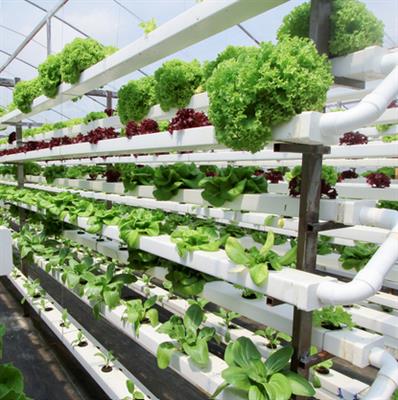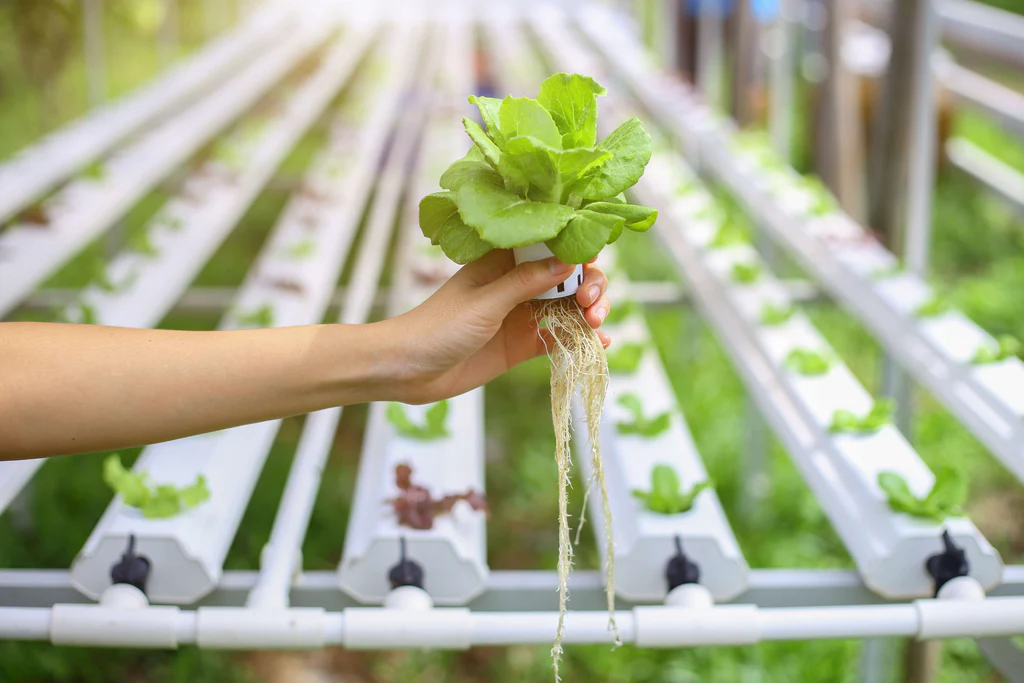What are the Benefits of Hydroponics?
Now that you understand the terms, you may wonder why the growing method is getting so much buzz. What are the pros of hydroponics, and why is this growing method so intriguing?
Many hydroponics benefits make this an attractive farming method for the modern world. Such systems benefit the planet, offer ways to feed the growing population, and offer food supply protections against climate change. We’ll describe ten of the most prominent benefits of hydroponics below.
1. Needs No Soil
The first and most clear benefit of hydroponics is that this growing method needs no soil. Why does this matter? Land degradation is a serious problem facing agriculture and the world today. As soil degrades, it becomes more and more difficult to farm in it.
Land degradation happens through both physical and chemical methods. Physical degradation relates to natural erosion and physical disturbance, as farming equipment may cause. Chemical degradation happens due to pollution and other types of contamination. Both kinds of degradation result in soil with fewer nutrients and less suited to growing healthy crops.
Hydroponic crops don’t contribute to soil degradation, so they can help slow land degradation. These crops aren’t affected by the results of this crisis either since they don’t rely on healthy topsoil for their nutrients.
LEARN ABOUT OUR HYDROPONIC TECHNOLOGY
2. Conserves Water
Water conservation is a primary concern in today’s world. It may seem counterintuitive to replace soil with water in a hydroponic system. In reality, such a system uses far less water than traditional, soil-based growing methods because the water used can be recycled repeatedly.
Outdoor farms lose a lot of water to evaporation and runoff. Pesticides and chemical fertilizers may also contaminate their water. A hydroponic greenhouse equipped to remove humidity from the air wastes very little water because the system recycles it. Such an approach doesn’t need dangerous chemicals to protect the plants from pests. Proper filtration and treatment allow the water to remain clean.
3. Facilitates a Micro-Climate
Technology in a hydroponic greenhouse allows growers to create the perfect conditions for each crop. Appropriate climate control in an enclosed system allows growers to program ideal micro-climates around each type of crop they grow.
One part of a hydroponic greenhouse may keep spinach at a chilly 55⁰ F. Another area may house romaine lettuce closer to 70⁰ F. When growers control micro-climates around each crop, they can produce more varieties in a single system.
4. Predictability and Seasonality
Most crops only grow in certain climates and during specific seasons. When people want summer crops in the dead of winter, grocers import them from other parts of the world. This contributes to the greenhouse gas crisis in transit.
Another issue revolves around predictability. So many factors contribute to crop yield. An early frost, drought, flood, or storm can destroy an entire field of crops and there is often nothing the farmer can do to stop it.
Indoor hydroponic farms allow growers to harvest predictable yields year-round. These crops grow all year long, regardless of weather or climate. And since they’re protected from problems that can cause crop failure, the yields are far more predictable.
5. Crops Grow Faster
One promising development in hydroponic technology is the ability to harvest crops faster than in other methods. When each plant has optimal growing conditions, crops can grow faster and larger.
Many hydroponic growers report that their crops grow in half the time (or even less) of soil-grown versions of the same crops. This speed is most prominent in green leafy vegetables, but there are gains for nearly every variety of hydroponic plant.
6. Maximizes Space
If you’re planning to go into soil-based farming on a large scale, you’re going to need a lot of space to do it. Most traditional farms are in rural areas because the cost of land in densely populated areas is too high to make the effort profitable. Again, this leads to the need to move crops across the country from where they are grown to where they will be consumed.
When you grow crops in an urban or suburban area you must maximize the available space to make the operation profitable. For urban growers, hydroponic vertical farming is an excellent choice. By stacking plants vertically, you can grow more at one time in the same amount of space. When you add in the faster growing time of hydroponic plants, this is an exceptional way to maximize the space you have.
7. Produces Higher Yields
Global food shortages are common enough that we should prepare for them as a matter of routine. A hydroponic greenhouse allows growers to produce healthy food in less time and with far greater yields.
Yes, hydroponic greenhouses grow crops faster and maximize the use of space. But they also rarely lose crops to problems like pests and contamination. All this leads to more crops to harvest, greater profits for growers, and the ability to feed people more predictably.
8. Require Less Labor
Soil-based farming is labor-intensive and can be grueling. While many parts of this growing method can be mechanized, steps like harvesting delicate crops still need a human touch.
While hydroponic greenhouses also use human labor, the compact nature of the facilities allows these tasks to be done more efficiently, meaning you can get more done with fewer people. Not only that, workers at these facilities are not subjected to dangerous chemical pesticides. Hydroponic careers take place in laboratory-like conditions that avoid the dangers of typical farm work and instead offer decent wages and benefits.
9. Shortens the Supply Chain
One of the greatest difficulties in our supply chain for fresh foods is the distance they must travel from the rural areas where they are harvested to the grocery store shelves where they are sold. If you’re a fan of your local farmer’s market, you probably understand how much better fresh fruits and vegetables taste. Hydroponic farming offers the opportunity to grow fresh foods within minutes or hours of the consumers who will eventually enjoy them.
Hydroponic farms allow grocers to stock fresher foods, often harvested within hours or days. They can also partner with hydroponic greenhouses to create white-label food options like bagged salads and fresh herbs. This shortened supply chain allows them to cut out middlemen and offer foods directly from the farm, straight to their customers.
10. Produces Higher Quality Food
Many people believe that food grown in a hydroponic system will taste watered down and lack essential nutrients. While this may be true for some home-based hydroponic growing systems, commercial hydroponic farms typically offer higher-quality crops than their soil-based counterparts.
Hydroponic crops enjoy carefully controlled environments and scientifically balanced nutrients in their water supply. They are not subjected to pollutants, pesticides, and other contaminants. Finally, they tend to be grown close to the areas where they will be consumed, so they are typically much fresher when they reach your table. All of this leads to crops that not only taste delicious but are at least as healthy as traditionally grown crops of the same type.


